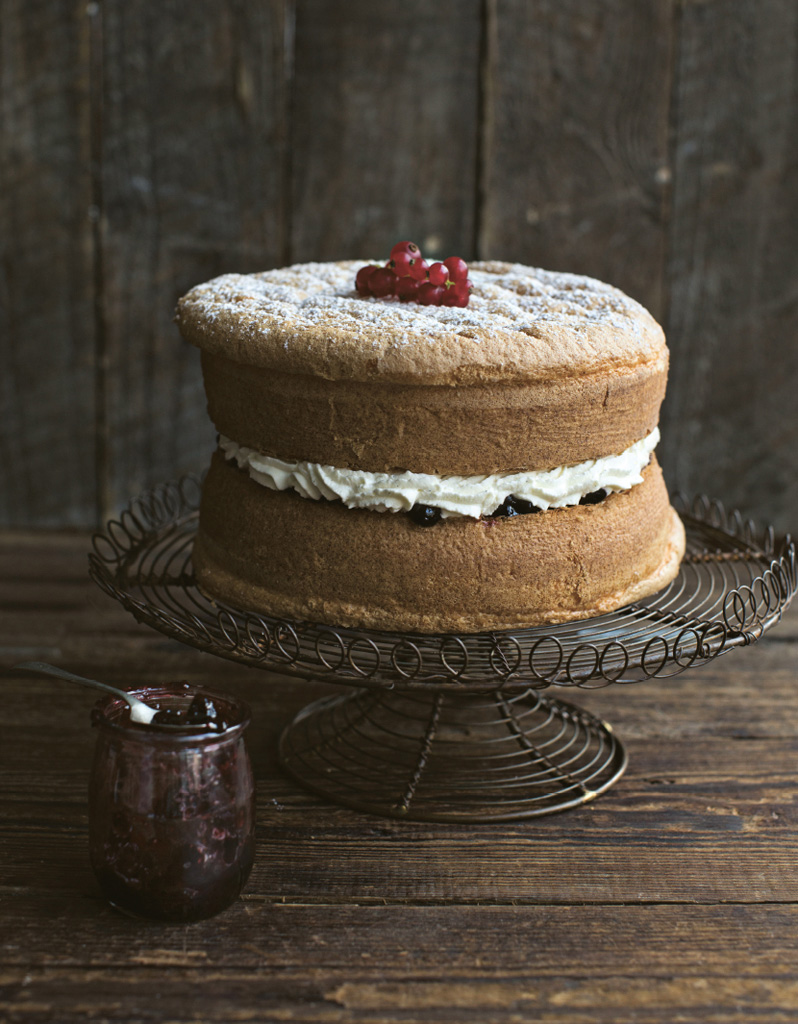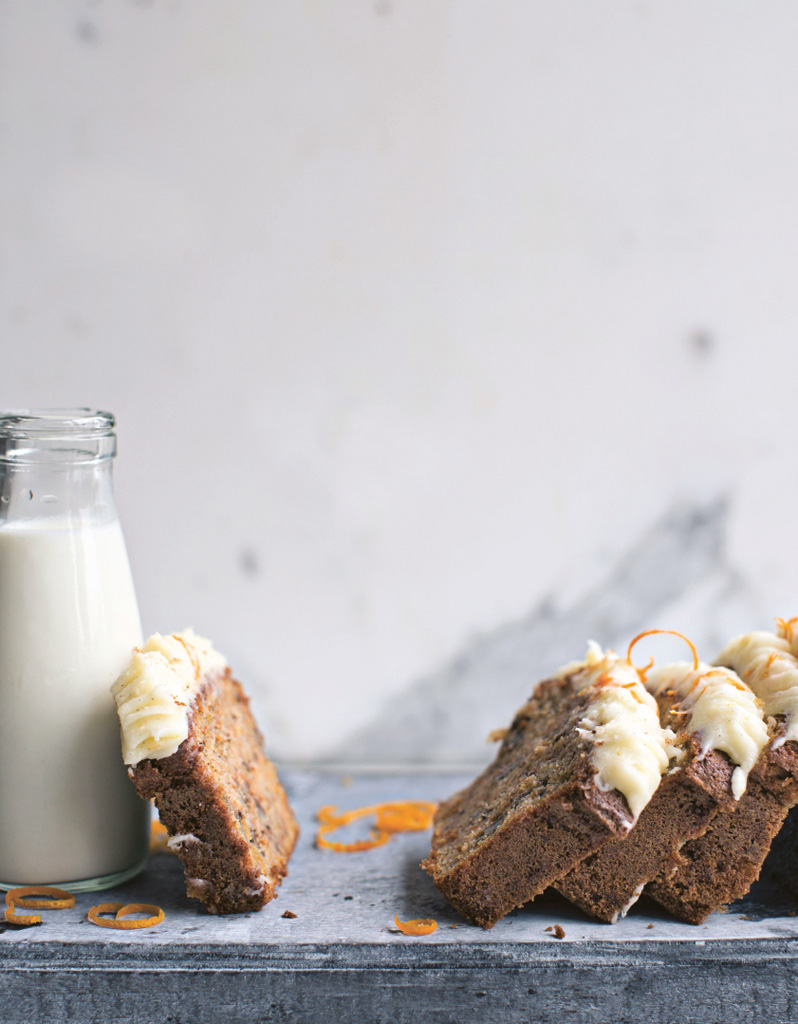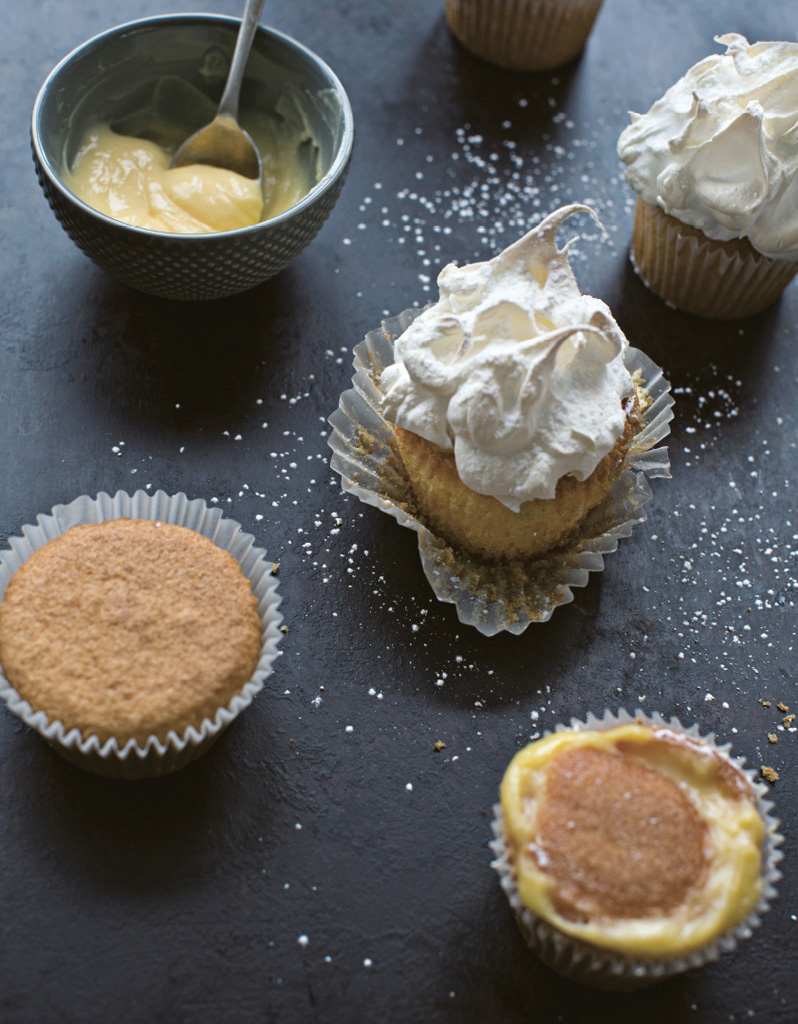
afternoon tea
AFTERNOON TEA is cooler than ever, but for those of us who are coeliac, it’s simply a nightmare. I would like to change that!

victoria sponge
This traditional sponge can be a component of many desserts or it can simply be served on its own with fresh cream and jam.
MAKES 2 X 20CM SPONGES
butter, for greasing
6 medium eggs, at room temperature
180g caster sugar
140g gluten-free self-raising flour
40g gluten-free cornflour
Preheat the oven to 180°C. Grease 2 x 20cm sandwich tins with a little butter and line the bases with non-stick baking paper.
Whisk the eggs and caster sugar together until you can form a peak with the whisk and it holds a figure of eight. This should take about 10 minutes. It helps to have the eggs at room temperature in order to achieve this.
Sieve the self-raising flour and the cornflour together, then gently fold into the egg mixture until just combined. Do not overmix.
Pour into the prepared tins and bake for 25–30 minutes, until the sponges shrink from the sides of the tin and spring back when gently pressed with a finger. The mixture will double in volume when baked.
GET AHEAD
You can make these sponges in advance and freeze them once they are well wrapped.

pear and almond scones
A delicious twist to a traditional scone.
MAKES 10 SCONES
150g gluten-free self-raising flour
150g gluten-free white flour blend
1 tsp gluten-free baking powder
½ tsp xanthan gum
½ tsp bread soda
½ tsp salt
40g caster sugar, plus extra for sprinkling
70g butter, cubed
1 egg
200ml buttermilk approximately
FOR THE FRANGIPANE FILLING:
200g butter, softened
200g icing sugar
200g ground almonds
40g gluten-free plain white flour, plus extra for dusting
4 eggs, separated
1 x 400g tin of pears, drained and sliced
flaked almonds, to decorate
Preheat the oven to 180°C. Dust a non-stick baking tray with a little gluten-free plain white flour.
To make the frangipane, cream the butter and icing sugar together in the bowl of a stand mixer using the paddle attachment until light and fluffy. This can take up to 10 minutes.
Mix the ground almonds and plain flour together. Add the egg yolks to the butter mixture along with half of the flour mixture and mix well. Add the egg whites and the remaining flour mixture and mix well again, scraping down the sides of the bowl. Put the frangipane mixture into a piping bag and set aside.
To make the scones, sieve all the dry ingredients together except the sugar, then mix in the sugar and rub in the butter until it’s a sandy texture. Make a well in the centre.
Whisk the egg and reserve a tablespoon of the egg to use later. Mix the remainder of the egg with 150ml of the buttermilk, then gently mix into the flour mixture until it’s incorporated. If the dough is not bound together yet, then add the rest of the buttermilk, little by little, until you achieve the required consistency.
Transfer the dough onto a floured board and pat down until it’s 3cm thick. Gentle handling is essential to produce a light scone. Use a 4cm scone cutter to stamp out the scones. Place the scones on the prepared baking tray.
Pipe a small ball of frangipane into the centre of each scone and place a slice of pear on top of each one. Brush the scones with the reserved tablespoon of beaten egg and sprinkle with caster sugar and some flaked almonds.
Place in the oven, then immediately reduce the temperature to 160°C and bake for 20–25 minutes, until the scones are well risen, golden brown and firm to the touch. Transfer to a wire rack and leave to cool.
GET AHEAD
Freeze whatever frangipane you don’t use to make another batch of scones on another day, as you only use a small amount in this recipe.

carrot cake
I have a sweet tooth, so a slice of this cake with a cup of coffee in the afternoon is just perfect. The cake has a soft, dense texture, flavoured by the addition of the cinnamon.
MAKES 2 X 1LB LOAVES
125g gluten-free self-raising flour
2 tsp gluten-free baking powder
1 tsp ground cinnamon
1 tsp salt
125g gluten-free brown bread flour
175g caster sugar
150ml sunflower oil
4 eggs
350g carrots, grated
100g walnuts, roughly chopped
FOR THE ICING:
300g icing sugar, sieved
125g cream cheese
50g butter, softened
zest of 1 orange
1 drop of vanilla essence
Preheat the oven to 180°C. Line 2 x 1lb loaf tins with non-stick baking paper.
Sieve the self-raising flour, baking powder, cinnamon and salt together in a bowl, then stir in the brown bread flour.
Whisk the caster sugar, sunflower oil and eggs together in a large bowl until it forms a batter. Add the flour mixture to the batter, then add the grated carrots and chopped walnuts. Mix until combined.
Pour into the loaf tins and bake for 50–60 minutes, until the cake springs back when you touch it. Allow the cakes to cool completely on a wire rack before icing them.
To make the icing, cream the icing sugar, cream cheese, butter, orange zest and vanilla essence together until it forms a smooth icing. Spread over the cooled cakes with a spatula.
GET AHEAD
The cake freezes well prior to icing.

basic cupcakes
This basic mix is moist and light and is good for making all types of cupcakes.
MAKES 12 CUPCAKES
125g butter, softened
125g caster sugar
2 eggs, separated
½ tsp vanilla essence or the seeds from 1 vanilla pod
125g gluten-free self-raising flour
15g cornflour
½ tsp xanthan gum
Preheat the oven to 180°C. Line a bun tray with cases.
Using the paddle attachment on your food mixer, cream the butter and sugar together until light and fluffy. This should take approximately 10 minutes. Add the egg yolks one at a time, mixing well between each addition, then add the vanilla.
Sieve the flour, cornflour and xanthan gum together to remove any lumps. Add one spoonful of the egg whites and one spoonful of the flour mixture to the butter mixture and combine well. Repeat the process until everything is combined.
Put the mixture into the bun cases using a spoon or piping bag and bake for 20 minutes. Allow to cool completely before icing with one of the toppings here.
GET AHEAD
The baked cupcakes freeze very well, so I recommend doubling this recipe. The cupcakes defrost relatively quickly when needed.
tiramisu cupcakes
MAKES ENOUGH FOR 12 CUPCAKES
250ml freshly brewed espresso
1 tbsp caster sugar
80ml Tia Maria
10ml brandy
200g mascarpone cheese
150ml single cream
1 batch of basic cupcakes (here)
1 tbsp cocoa powder, for dusting
gluten-free chocolate shavings, to decorate
Combine the hot coffee with the caster sugar. Ensure all the sugar has dissolved before adding the Tia Maria and brandy. Leave to cool.
Using an electric whisk, mix the mascarpone cheese and the single cream together until they hold soft peaks.
Cut a small hole in the top of each baked cupcake and pour in some of the coffee mixture. Replace the top of the cupcake, then pipe the icing on top. Dust with cocoa power and decorate with chocolate shavings.
walnut and honey cupcakes
MAKES ENOUGH FOR 12 CUPCAKES
250g icing sugar, sieved
125g butter, softened
½ tsp vanilla essence
50g full-fat cream cheese
1 tbsp single cream
2 tsp honey
1 batch of basic cupcakes (here)
50g walnuts, chopped
Cream the icing sugar, butter and vanilla essence together. Add the cream cheese, cream and honey and whisk until light and fluffy. Place in a piping bag and pipe onto the baked cupcakes. Decorate the cupcakes with the chopped walnuts.
lemon meringue cupcakes
Only make the meringue when the cupcakes are ready for use, as it needs to be used straight away for a good result.
MAKES ENOUGH FOR 12 CUPCAKES 1 BATCH OF BASIC CUPCAKES (HERE) • FOR THE LEMON CURD:
1 leaf of gelatine or 1 tsp powdered gelatine
175g caster sugar
5 eggs
125ml single cream
zest and juice of 3 lemons
FOR THE MERINGUE:
3 egg whites (100g)
150g caster sugar
icing sugar, for dusting
To make the lemon curd, soak the gelatine leaf, if using, in a bowl of cold water. Mix the sugar, eggs and cream together, then whisk in the lemon zest and juice. Transfer to a saucepan and bring to the boil over a medium heat, stirring continuously. Remove from the heat, add the soaked gelatine leaf or powdered gelatine and leave to dissolve. Once cool, spoon the lemon curd into a piping bag and set aside.
To make the meringue, use the balloon whisk attachment on your mixer to whip the egg whites to soft peaks. Gradually add the caster sugar, whisking on a high speed until it’s stiff and glossy. This should take about 10 minutes. You can use a piping bag with a nozzle to pipe the meringue onto the curd.
To assemble, preheat the oven to 180°C. Cut into the centre of each cupcake with a pointed knife, removing a small amount of the bun. Pipe in about 1 teaspoon of the curd and replace the cupcake top. Once all the cupcakes have been filled, pipe the meringue onto each one, finishing with a dramatic swirl. Dust with icing sugar and bake in the oven for 4–5 minutes, until the top is set and slightly coloured.
GET AHEAD
This makes more lemon curd than you will need for the cupcakes, but it keeps for up to two weeks in a sealed container in the fridge. Or you could use it in combination with whipped cream for a lemon curd pavlova using the recipe for pavlova nests here.
emma’s chocolate chip cookies
My daughter Emma cannot resist these and plagues me to make them. This cookie recipe may look like it has a lot of ingredients, but once the raw cookie dough is rolled in cling film and refrigerated, it will keep in the fridge until required for up to one week. These are very popular in my house, especially for parties. They have a lovely short texture and are very satisfying.
MAKES 30–40 COOKIES
225g butter, softened
150g Demerara sugar
100g coconut palm sugar or caster sugar
½ tsp vanilla essence or the seeds of 1 vanilla pod
2 eggs, separated
300g gluten-free self-raising flour
50g coconut flour
1 tsp bread soda
½ tsp gluten-free baking powder
½ tsp xanthan gum
pinch of salt
125g gluten-free white chocolate drops
125g gluten-free dark chocolate drops
Preheat the oven to 180°C.
Using the paddle attachment of your food mixer, cream the butter, Demerara sugar and coconut palm sugar together until the mixture is light and fluffy. This should take about 10 minutes. Mix in the vanilla, then add the egg yolks and mix well to combine.
Sieve the self-raising flour, coconut flour, bread soda, baking powder, xanthan gum and a pinch of salt together.
Add half the egg whites and half the flour mixture to the butter and sugar mixture and mix until the egg whites and flour are fully combined with the butter mix, scraping down the sides of the bowl during the process. Add the remaining egg white and flour and mix again, then add the chocolate drops and mix through.
Break off a heaped dessertspoon of the dough and place on a non-stick baking tray. Bake for 8–10 minutes, depending on the size. The cookies will be light brown in colour when baked. Remove from the oven and allow to cool directly on the tray. You can store the cookies for up to a week in an airtight container.
GET AHEAD
If you want to use the dough later, then form it into a cylinder, wrap it tightly in cling film and place in the fridge until required. The dough will keep for up to a week. Or you can freeze it and defrost it when required. Either way, slice the dough into 1cm-thick circles to bake.

ginger shortbread biscuits
Real butter brings out the flavour of these biscuits, which are the perfect accompaniment to a cup of coffee or served alongside the crème brûlée here or a trifle. I enjoy making these biscuits with the children, as they can be decorated with icing. You can also use chopped pistachios or the zest of one lemon instead of the crystallised ginger.
MAKES 12–15
200g gluten-free plain white flour
150g butter, softened
75g caster sugar, plus extra for dusting
1 vanilla pod, split in half and seeds scraped out
40g crystallised ginger, chopped
Preheat the oven to 160°C. Line a baking tray with non-stick baking paper.
Mix the flour, butter, sugar and vanilla seeds together to form a crumb mix. Add the chopped ginger and bring together to form a dough. Roll into a cylinder and cut into 1cm-thick circles. Place on the lined baking tray.
Bake for 20–25 minutes, until the biscuits are firm to the touch and pale in colour. Leave to cool directly on the tray and dust with caster sugar until fully covered.
Store the biscuits in an airtight container and use within a week.

